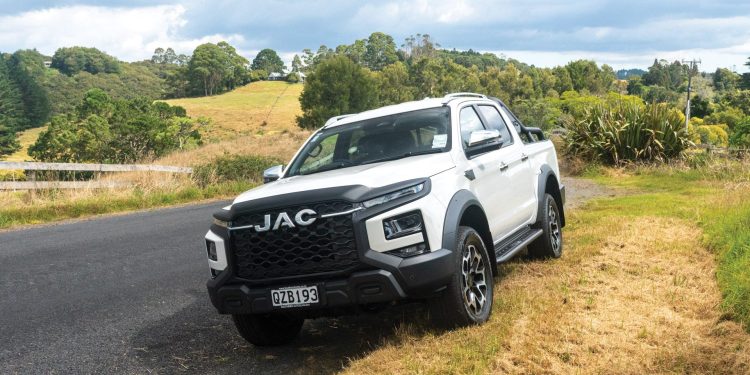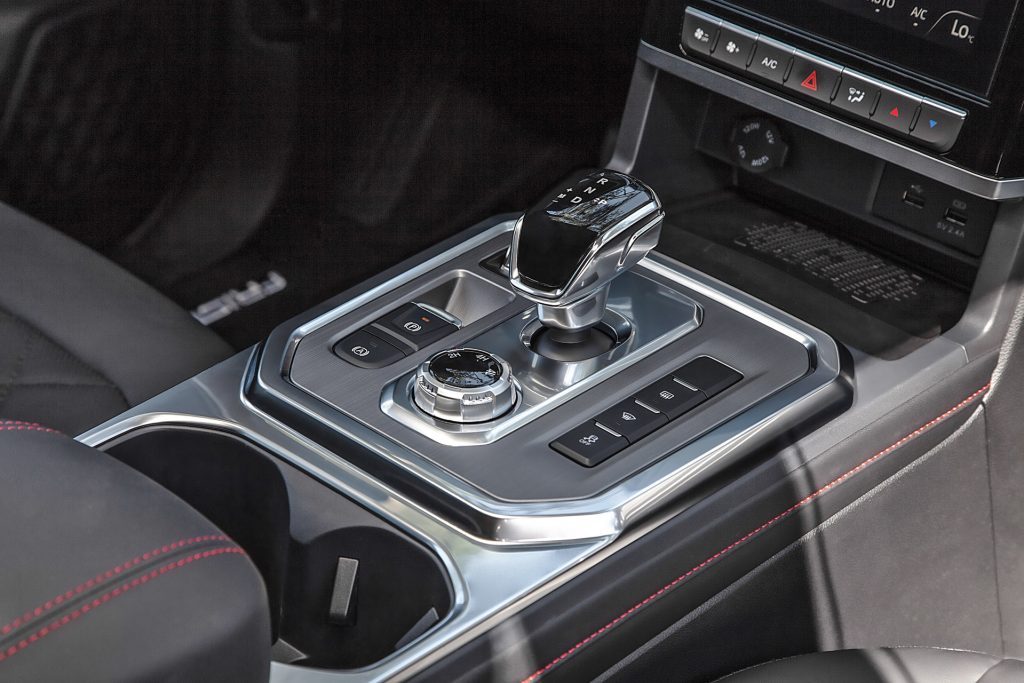2025 Jac T9 Review
Words: Peter Louisson | Photos: PL
Utes are still big business, despite a drop-off recently. Could that be because of less expensive newcomers? We try out the recently released JAC T9.
It could well be the year of the ute, if our COTY winner is any indication. For ever so long, utes have been available as diesel 4X2 or 4X4 variants. And not much else. Suddenly, that’s all changing, with mild hybrids and PHEVs incoming.
And then there are simply less pricey new diesel utes available, like the one you see here, packed with safety items, AWD and low range, all for not unreasonable money. In the case of the new JAC T9 (pronounced Jack Tee Nine) it’s just shy of $50k, before ORCs.
One high-spec model
The T9 arrives here as a single well specified double-cab AWD variant. JAC General Manager, Andrew Craw, says the T9 is “targeted at the Kiwi tradie market…and is stacked with features and extras.”
JAC may be a new brand to most – it actually stands for Jianghuai Automobile Company – but it has been operating here for some time as a purveyor of light trucks via the Southpac Group. Colonial Motor Company has also come on board, with nine new JAC dealers dotted throughout the land.
The ute itself isn’t new per se either, just to New Zealand. Already almost one-third of a million have sold in the bigger ute markets.

Good warranty, top safety score
Like most machines from China, the buyer is well covered with a five-year/200,000km warranty deal. And you’re also secure on the crash front, with a recent (2024) five-star rating. The T9 performed well on all four criteria, with scores ranging from 85 to 89 per cent. Interestingly, the top score was for safety assist which addresses all the driver assistance systems on board. It has 18 in total, all with three-letter acronyms.
Left to its own devices, this bongs at you incessantly. However, they’re easy enough to silence.
First, the overspeed alert, the most irksome. Swipe across to the app part of the main screen, hit the car icon, go to driver assist systems and scroll down to turn off the overspeed alert. While you’re there, silence Lane Keep Assist and Driver Attention Alert. You can tape over the camera if you like which also silences the latter.
Right, so now you’re set to actually drive the thing. The foreplay isn’t as awful as it sounds; that takes about 30sec each time you hit go.
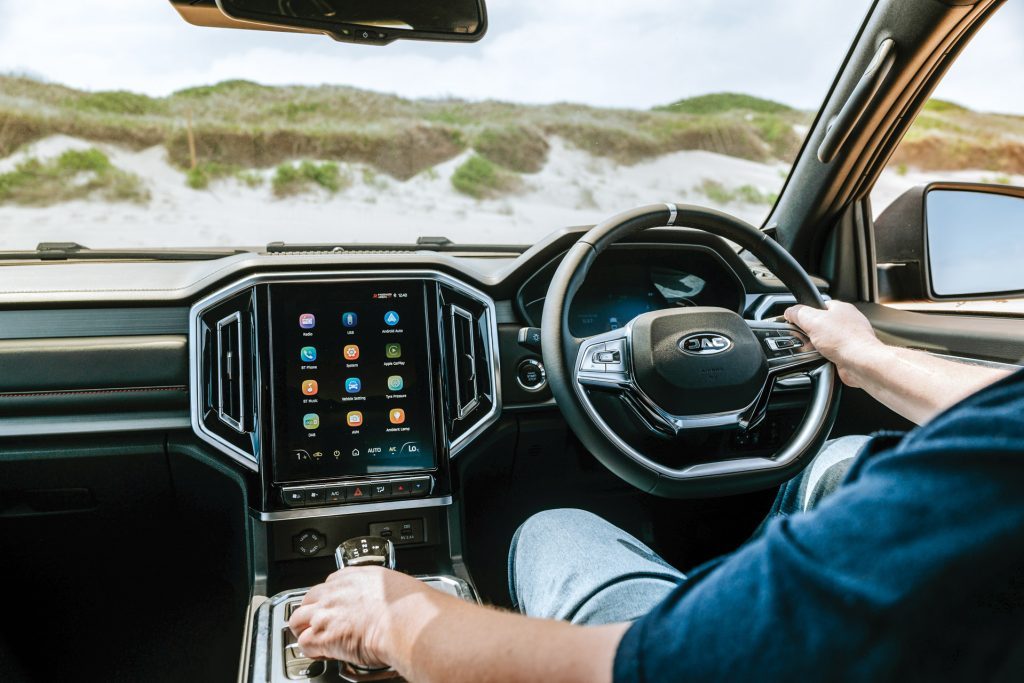
Underway then
In many ways, this is your straight up part-time 4×4 double-cab ute that just happens to be highly specified, with the component quality keeping the price real. Figure on lots of hard plastics in the cabin. No biggie for there are some surprise items too, like ambient lighting, keyless entry and push button start, and leather-clad wheel and seats, the latter with power driver adjustment. Externally, there’s a sports bar and running boards. Missing is a four-way adjustable steering column; it’s up and down only. And there’s no lumbar adjustability of any sort for the driver. But fear not, because the seat is really rather plush and supportive. We spent a few hours at the wheel at a time with no sore bits to report.
Most diesel utes are a bit rattly in operation, especially when cold. But this engine, which is hardly class-leading on the output front – 125kW/410Nm – is relatively subdued in action. Actually, the whole thing is, with a dB high in the 65s, not unheard of for a ute but it’s still impressively hushed. If you’re a passenger in the rear there’s more than adequate head and knee room, and even three will fit across the back there. However, don’t expect underseat storage like in some as the seats are essentially fixed, other than a pulldown armrest in the middle.
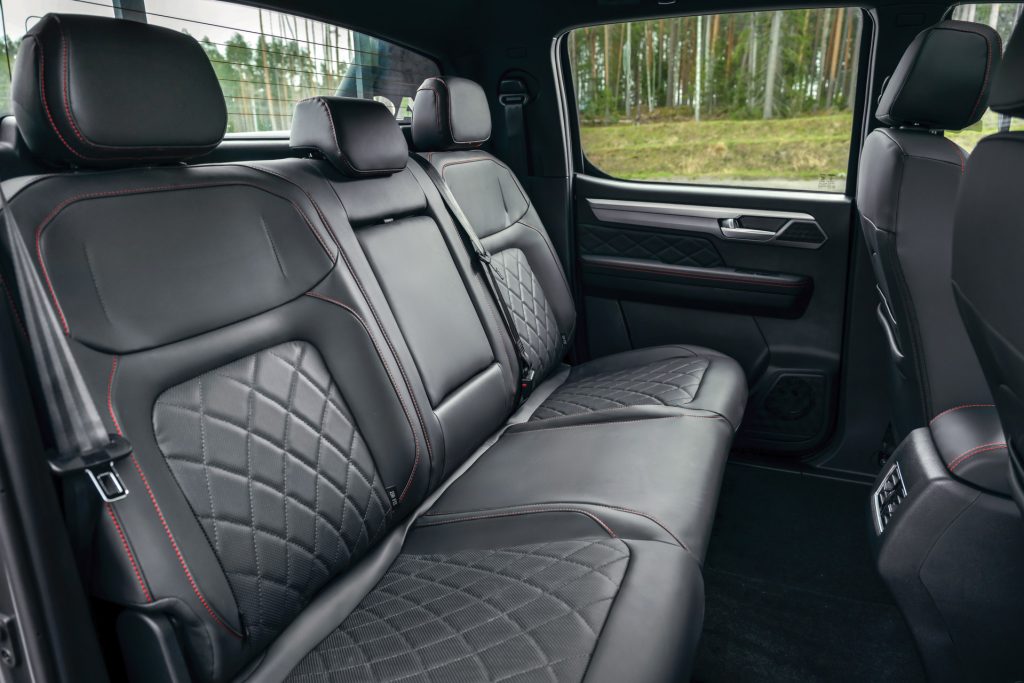
How’s it go?
Actually, not too bad, all in all. Pretty good in fact. And that’s because it features an eight-speed auto, just right to extract whatever performance is hiding within the relatively low revving diesel powerplant. It’s not that quick against the clock – getting to 100 takes over 12sec – but then most in the class aren’t that much quicker either. Nor will it tow as much as the class leaders, with a braked maximum tow rating of 3.0 tonnes. However, the wellside is roomy; it will evidently accept a Euro pallet handily, and the payload maximum is a claimed 1045kg. At the rear, the tailgate is undamped.
On the go, this is refined and pretty easy on fuel. JAC says 7.6L/100km overall while Rightcar counters with 8.4. We saw figures in the nines almost the entire time we were driving it, though a reset on the motorway had it resume at 8.2L/100km. The worst was 10L/100km.
Ride and handling a genuine surprise
This is pretty much your average ute in terms of construction, body on frame, leaf springs, that sort of thing. We were almost shocked at how well it rode and handled though, not expecting that much really given its pricing. On the open road, unladen, the ride we found roughly as good as any in the class, for the most part. There’s not much in the way of jiggle, especially at 100km/h. Obviously at slower speeds, the ride isn’t quite as resolved. But it also hangs on in there, really in rather determined fashion within the confines of its tyres (Giti 4×4 HT 265/60R18s) and elevated ride status. Push too hard and there’s some gentle tyre squeal as the ESP steps in to keep things on track. Even the emergency stops weren’t too bad for a vehicle of its type (37.9m). When stationary, the brake pedal goes almost to the floor but in use it doesn’t. We appreciated the auto hold function too.
A wireless phone charger was an unexpected finding in the JAC T9. There’s also a 220V power point in the back for charging power tool batteries.
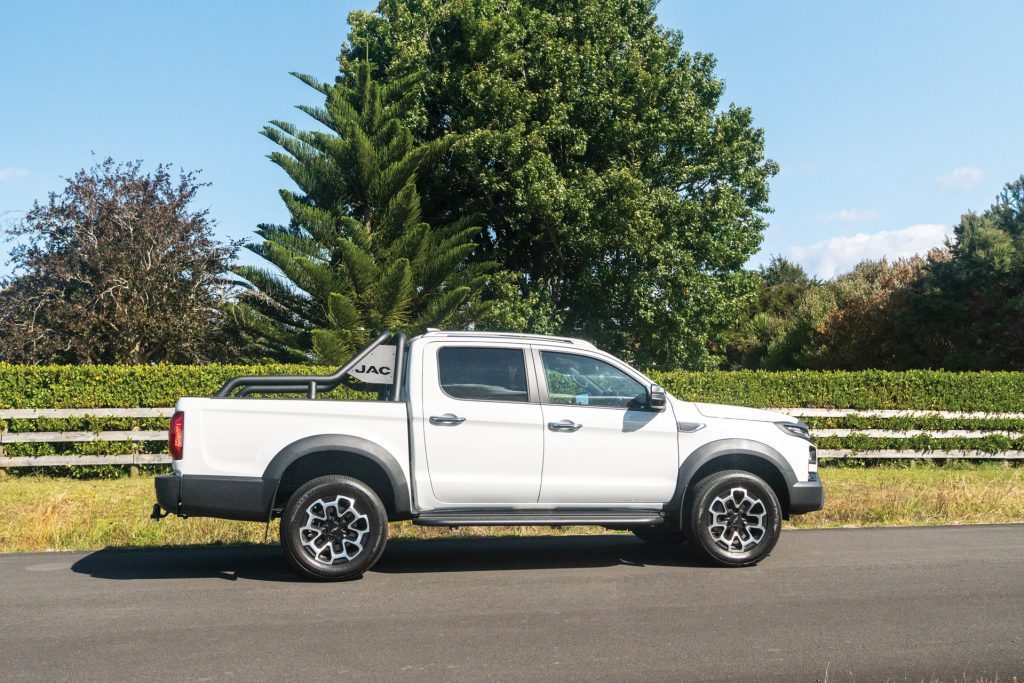
So to its archrival
In isolation this seems to be pretty darn good on the value front. Only GWM is here to spoil the party with its updated dual-cab 4×4 Cannon ute. It sports a 2.4 turbodiesel making a decent wedge more torque (480Nm) than the JAC’s 2.0 unit.
And it is rated to tow braked loads of 3500kg, 300kg more than the JAC. Cannon also features a nine-speed automatic transmission, and updated styling on both sides of the glasshouse.
It too has a five-star ANCAP rating. All of which is well and good but the real kicker is the price at $43,490, and its seven-year unlimited kilometre warranty. Check p60 (if you haven’t already) to see how that one stacks up.
What’s needed clearly is a comparison of this value-rated pair.
As to the future, we’d expect the option of a JAC T9 PHEV variant at some point, given it’s available overseas.
JAC T9
$49,990 / 8.4L/100km / 193g/km
0-100 km/h 12.37s
80-120 km/h 9.66s (275m)
100-0 km/h 37.90m
Speedo error 97 at an indicated 100km/h
Ambient cabin noise 65.5dB@100km/h
Engine 1999cc / IL4 / TDI
Max power 125kW@3600rpm
Max torque 410Nm@1500-2500rpm
Drivetrain 8-speed auto / switchable 4×4
Front suspension Wishbones / swaybar
Rear suspension Solid axle/leaf springsr
Turning circle 12.4m (3.1 turns)
Front brakes Ventilated discs
Rear brakes Discs
Stability systems ABS, ESP
Safety AEB, ACC, BSM, LDW, RCTA, ALK, AHB
Tyre size f/r-265/60R18
Wheelbase 3110mm
L/W/H 5330 / 1965 / 1920mm
Track f-1610mm r-1610mm
Fuel capacity 76L
Tow rating 750kg (3000kg braked)
Service intervals 12 months / 15,000km
Warranty 5yrs / 200,000 km
ANCAP rating ★★★★★ (2024)
Weight (claimed) 2055kg


